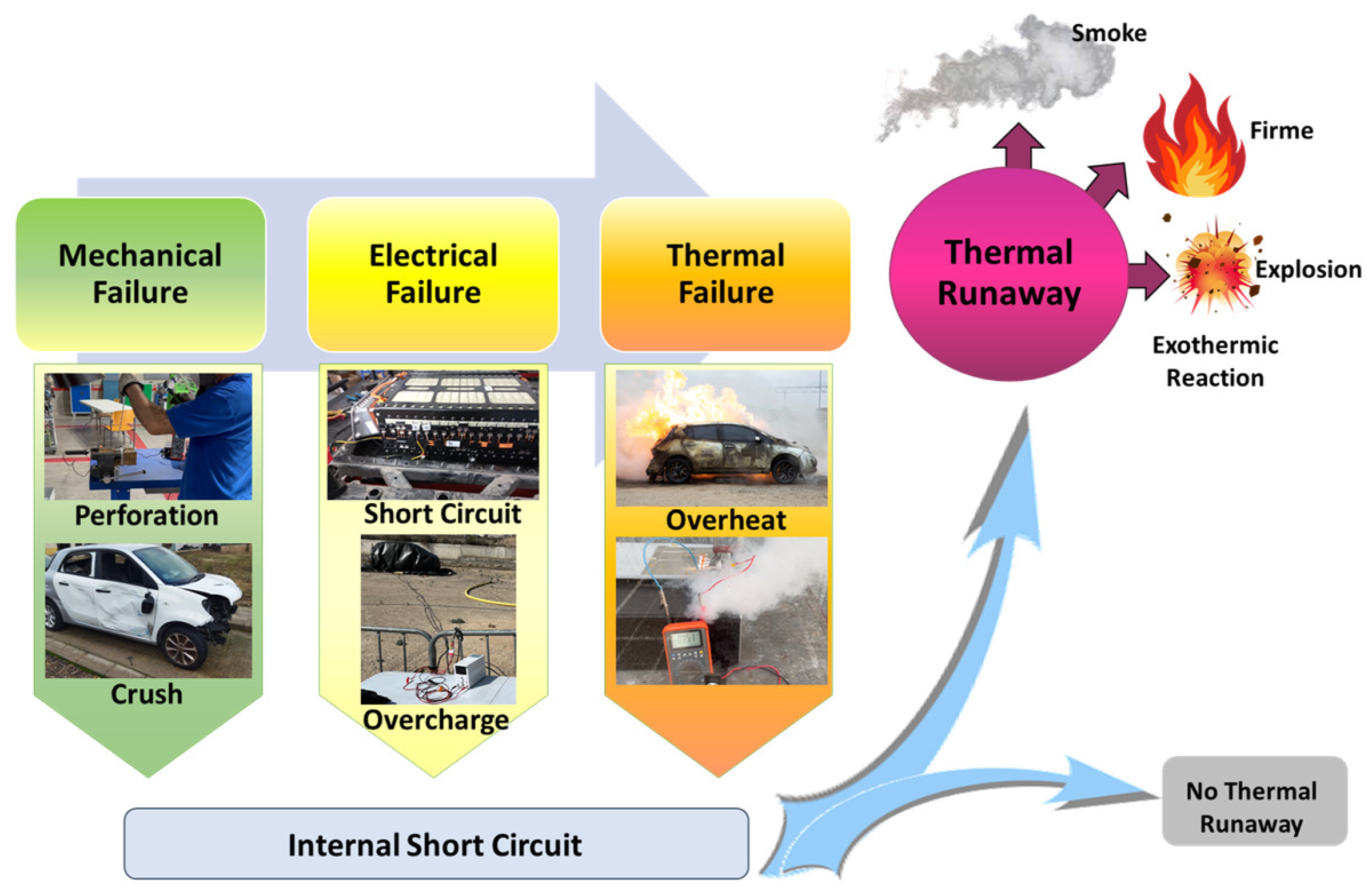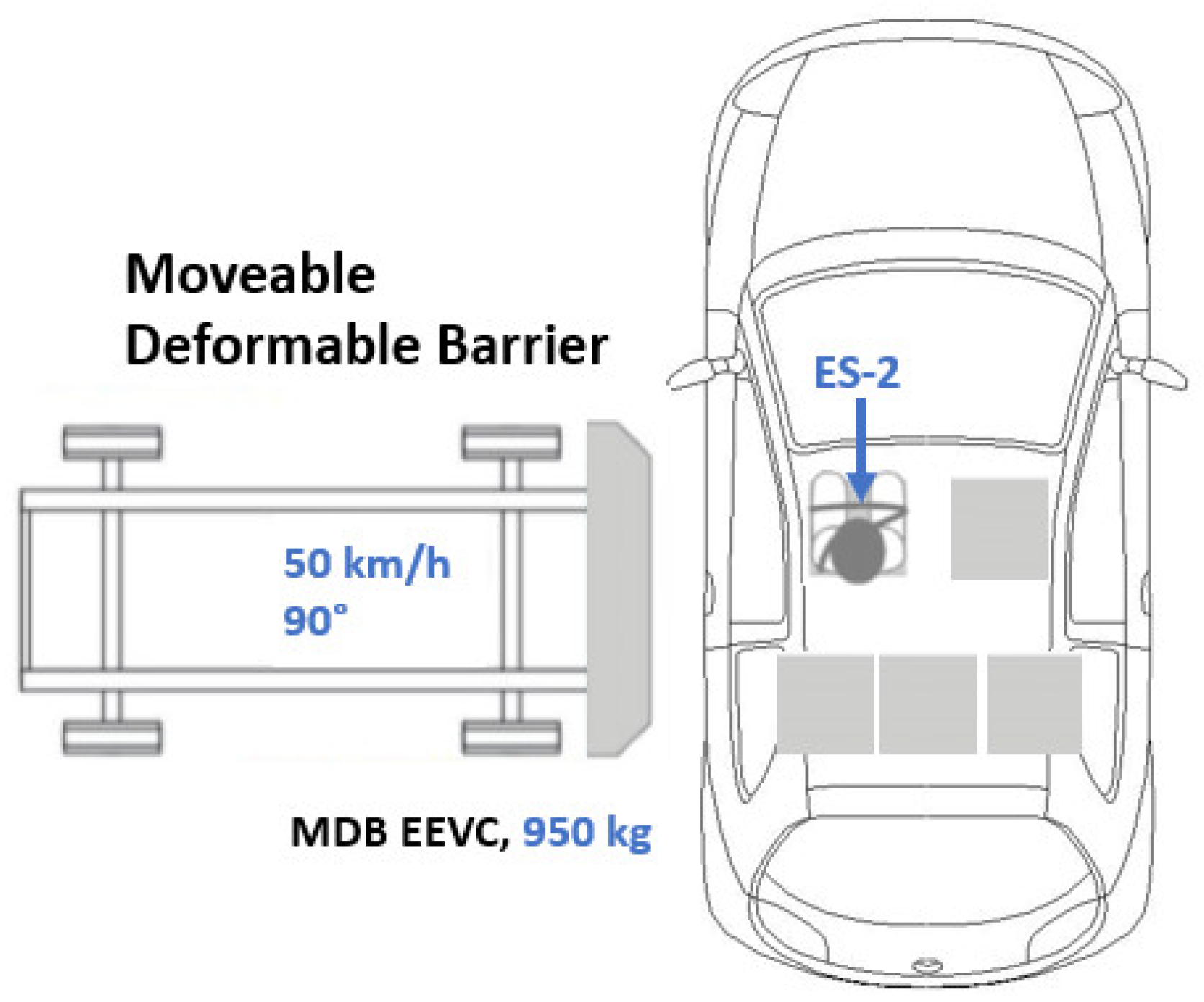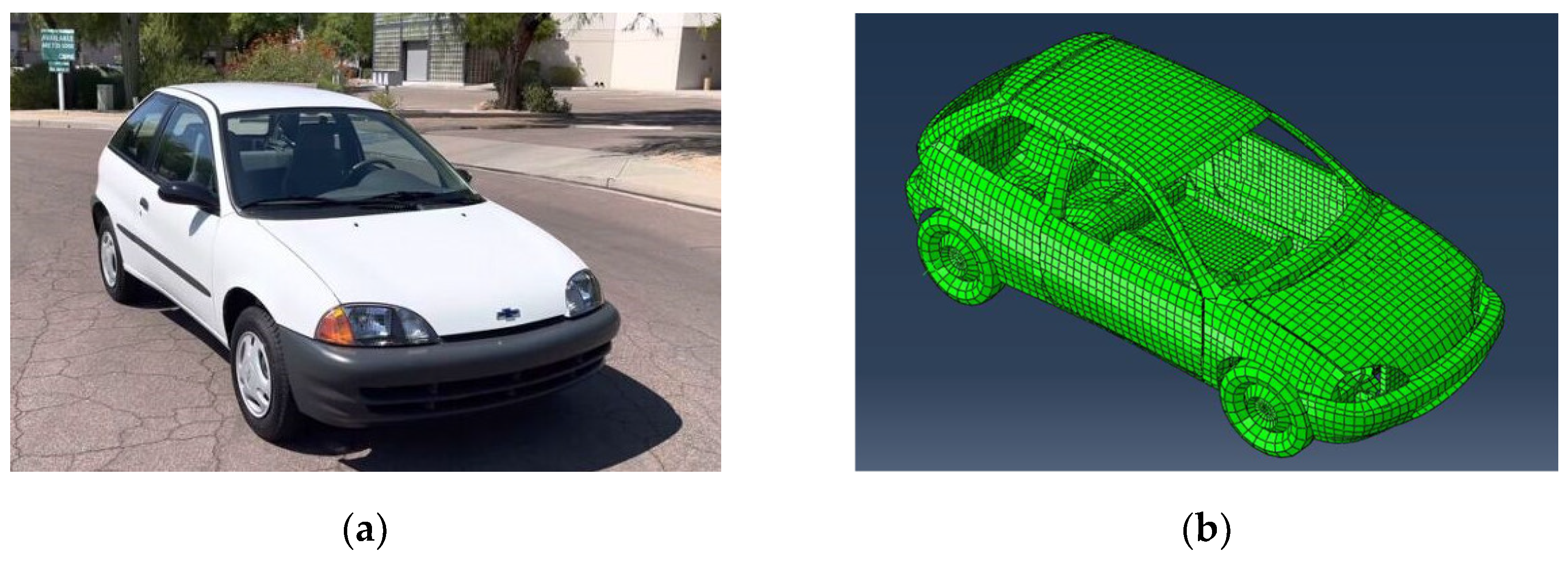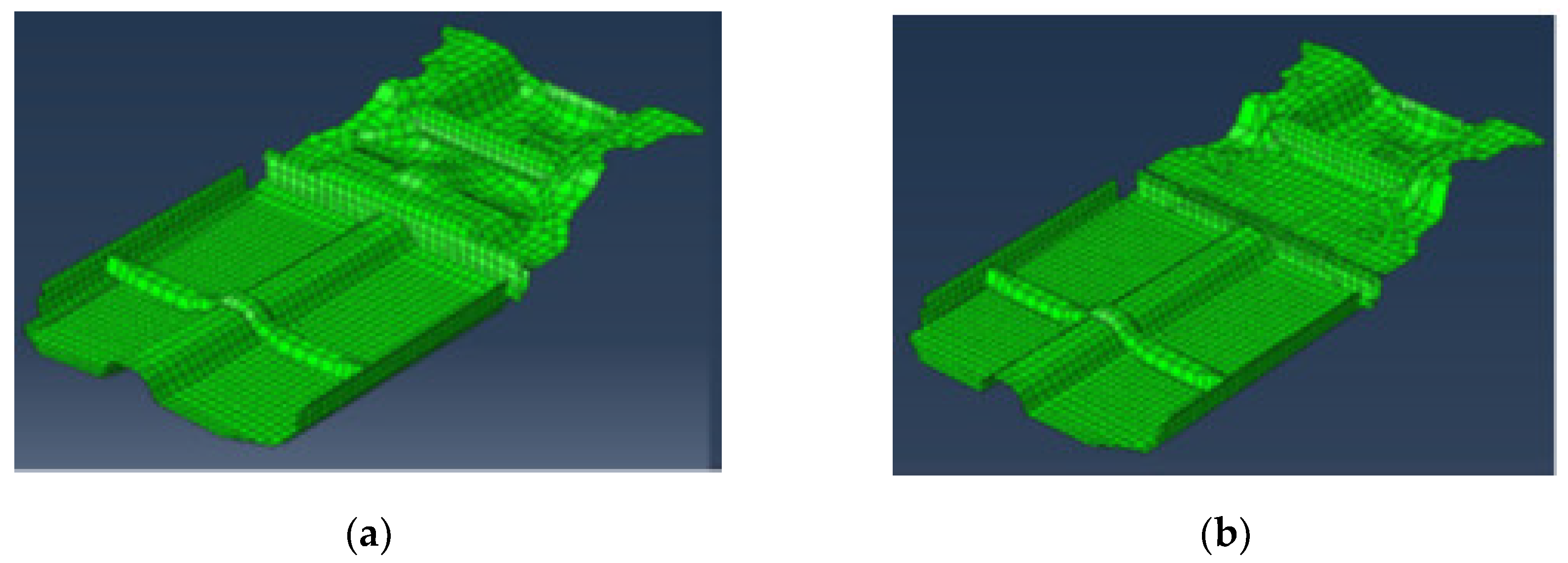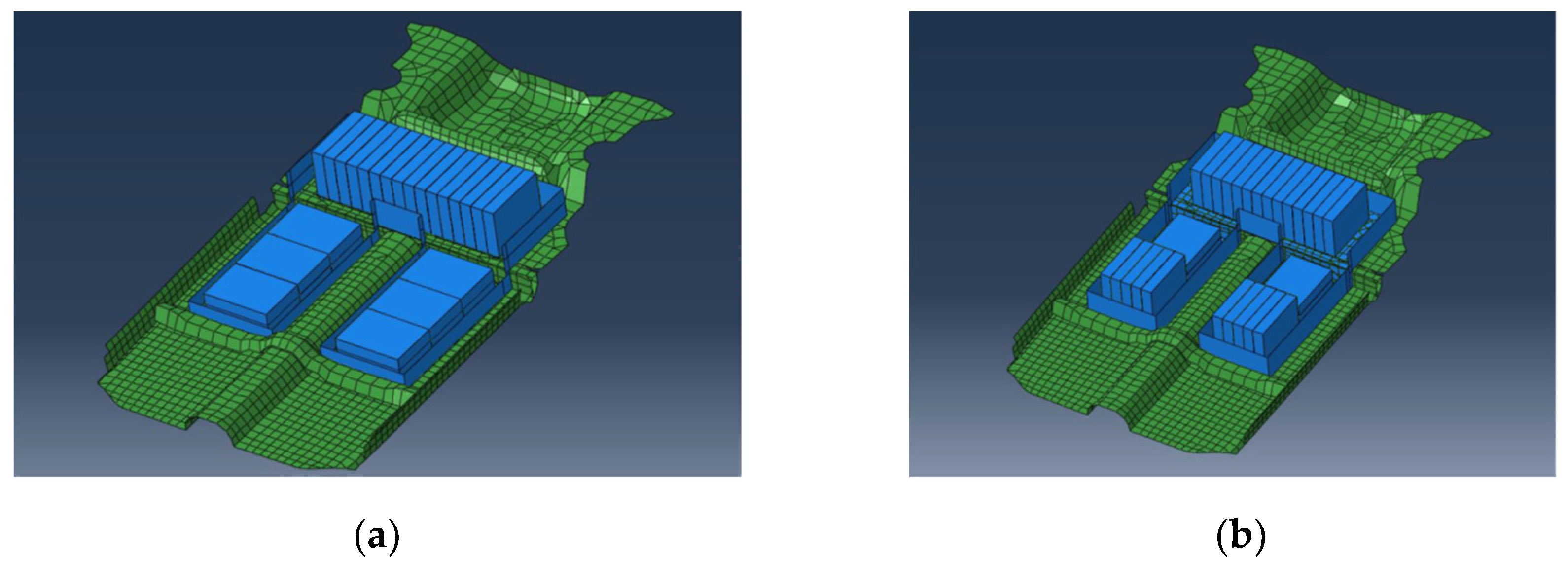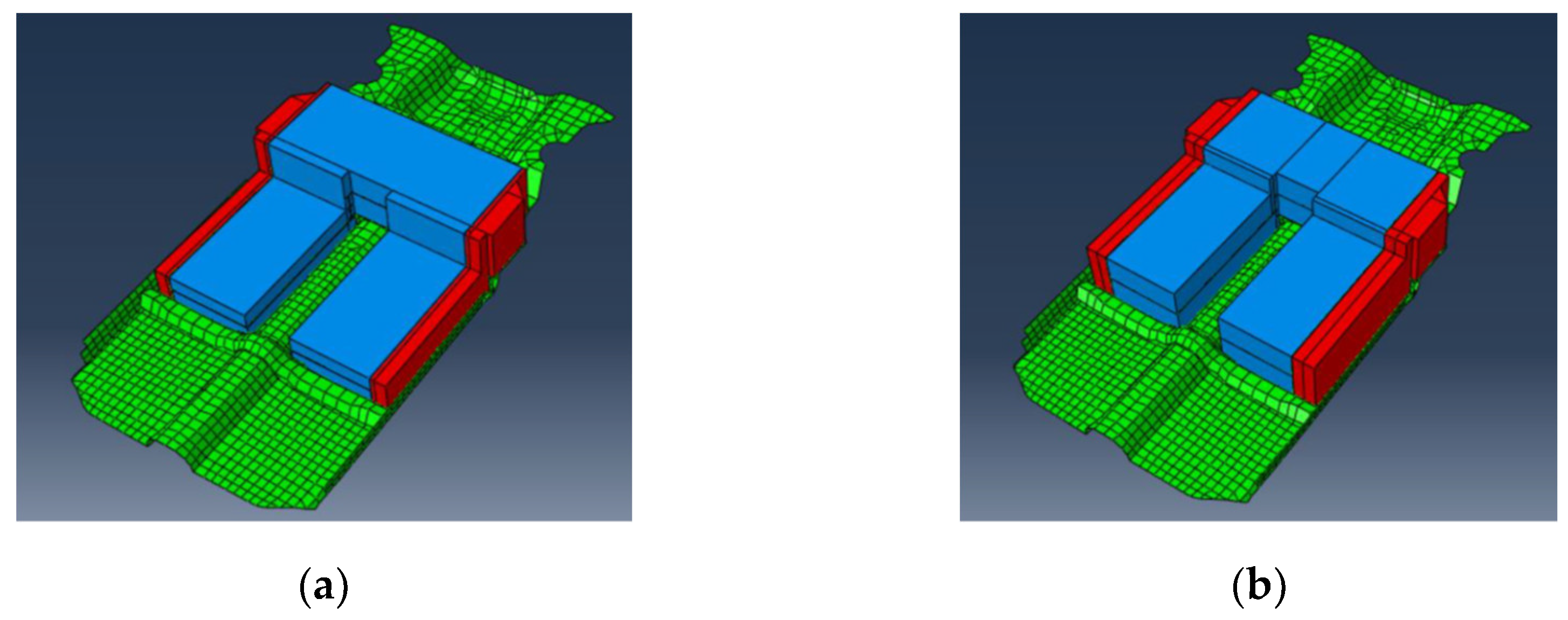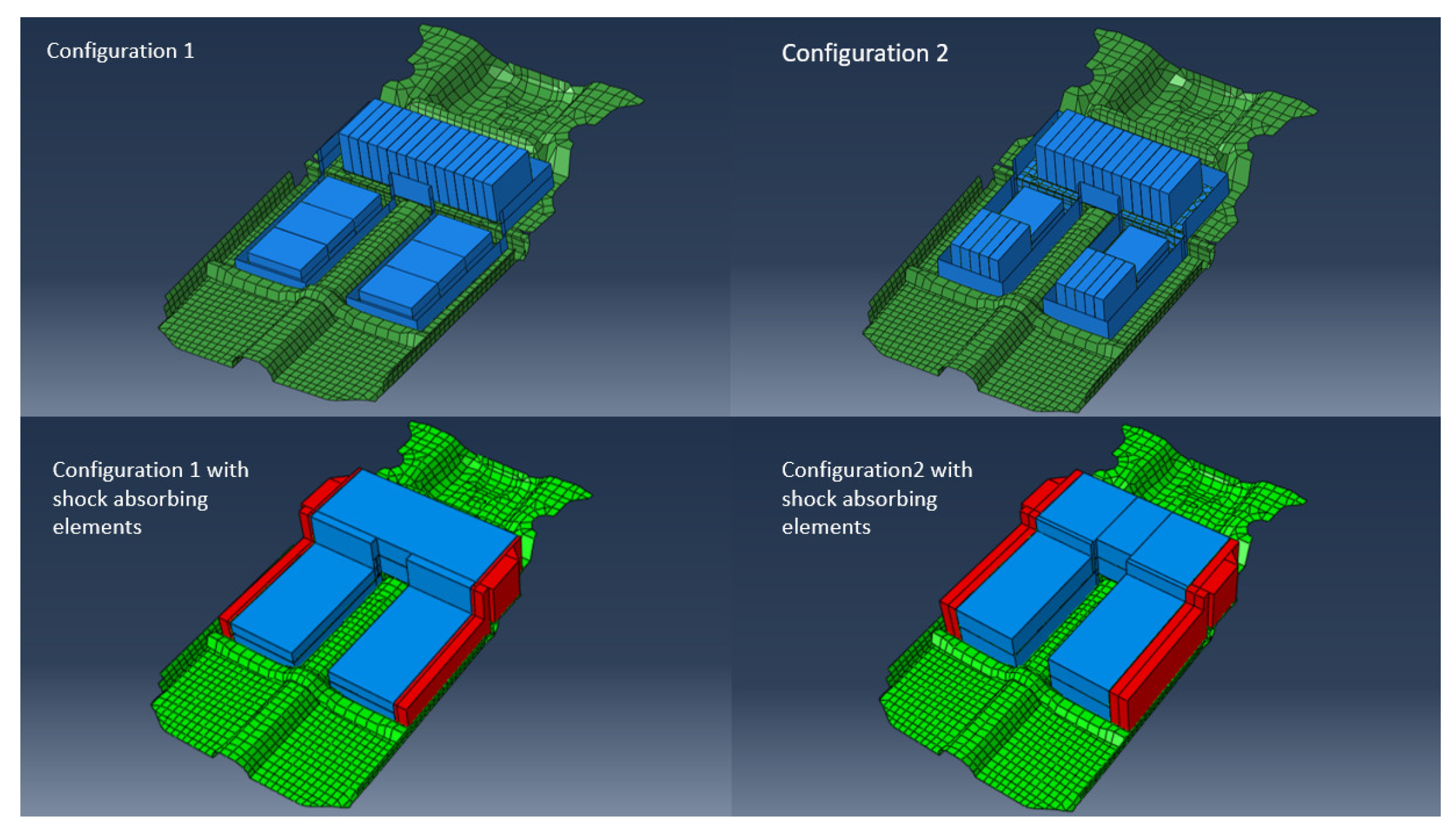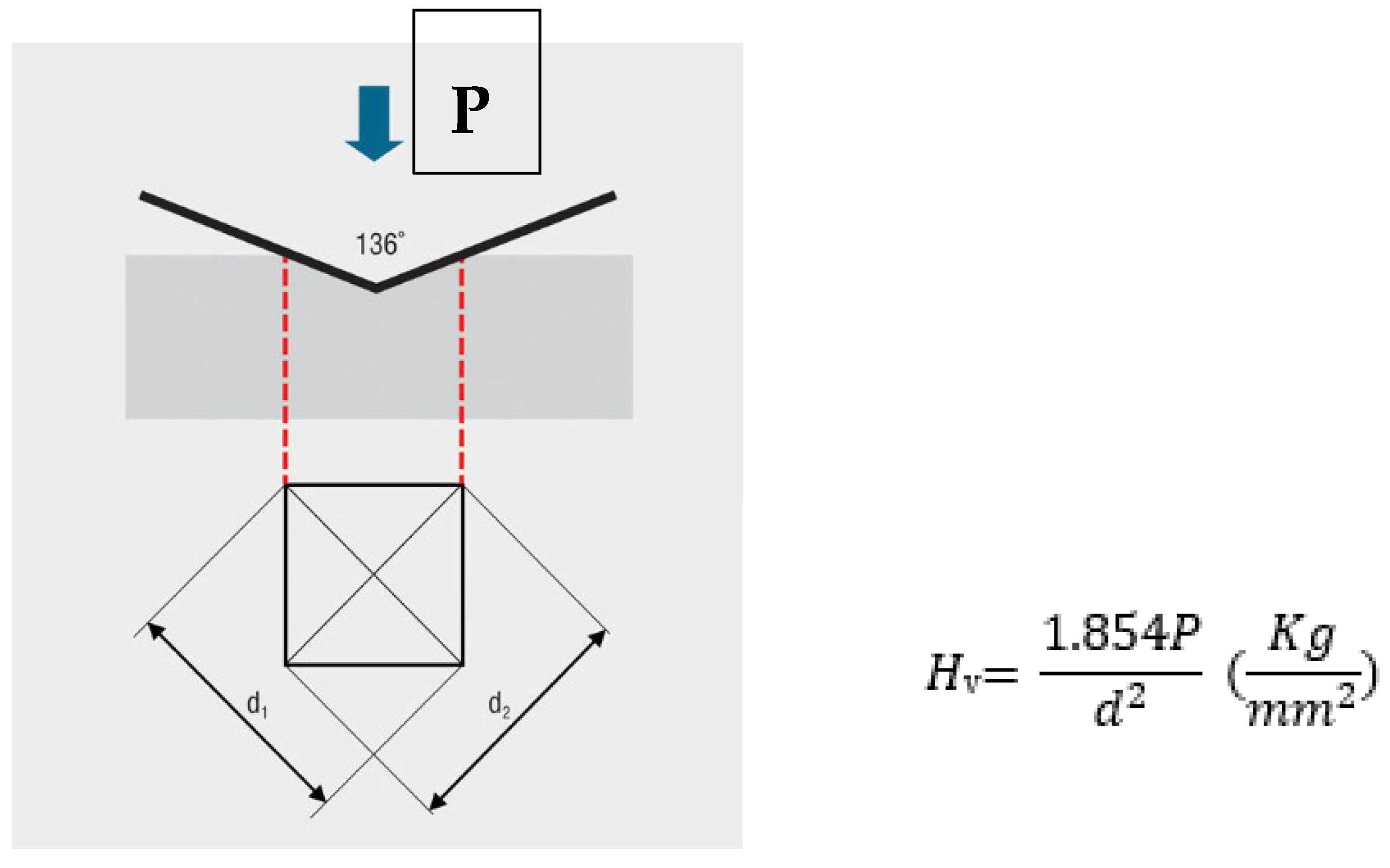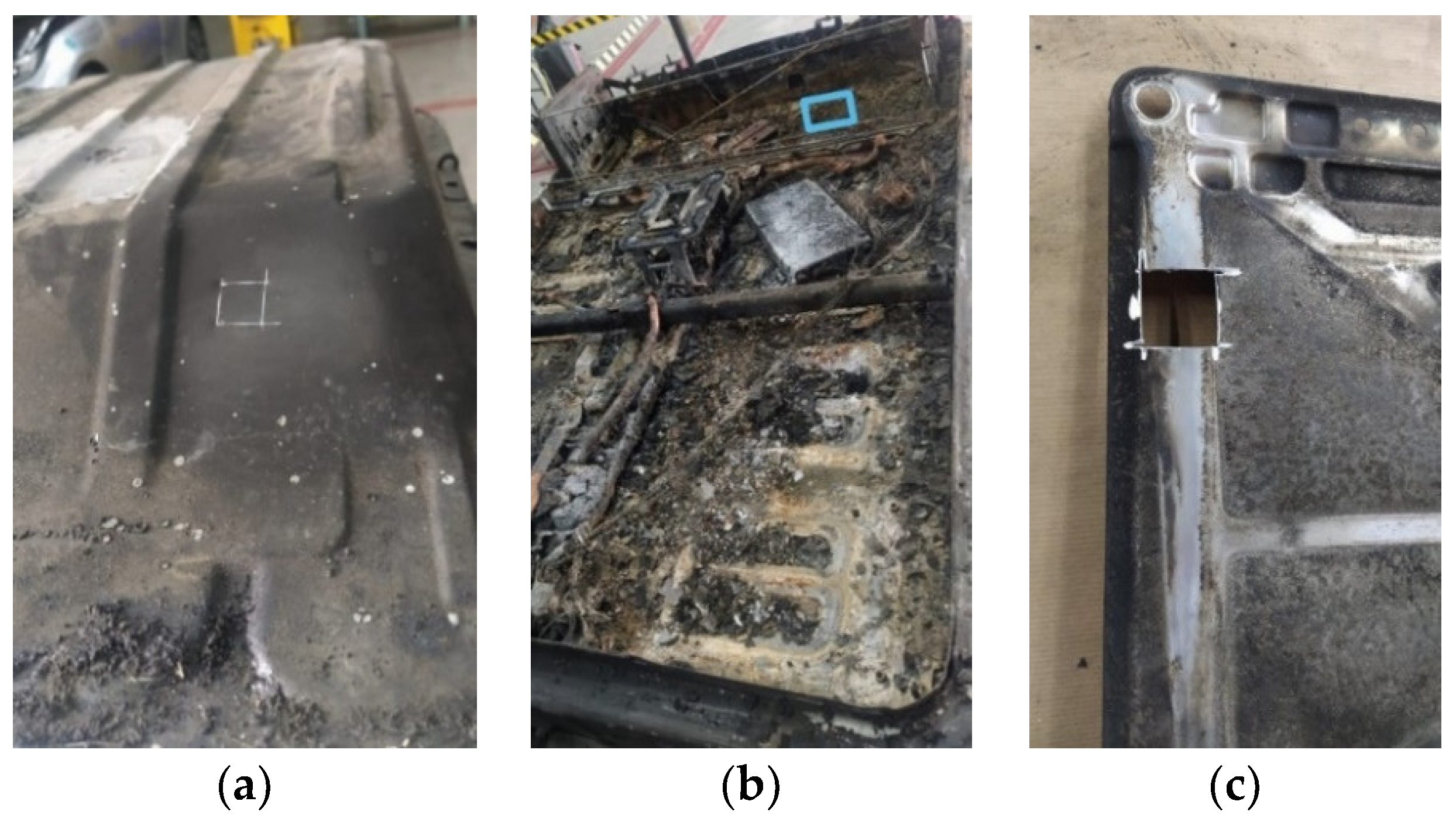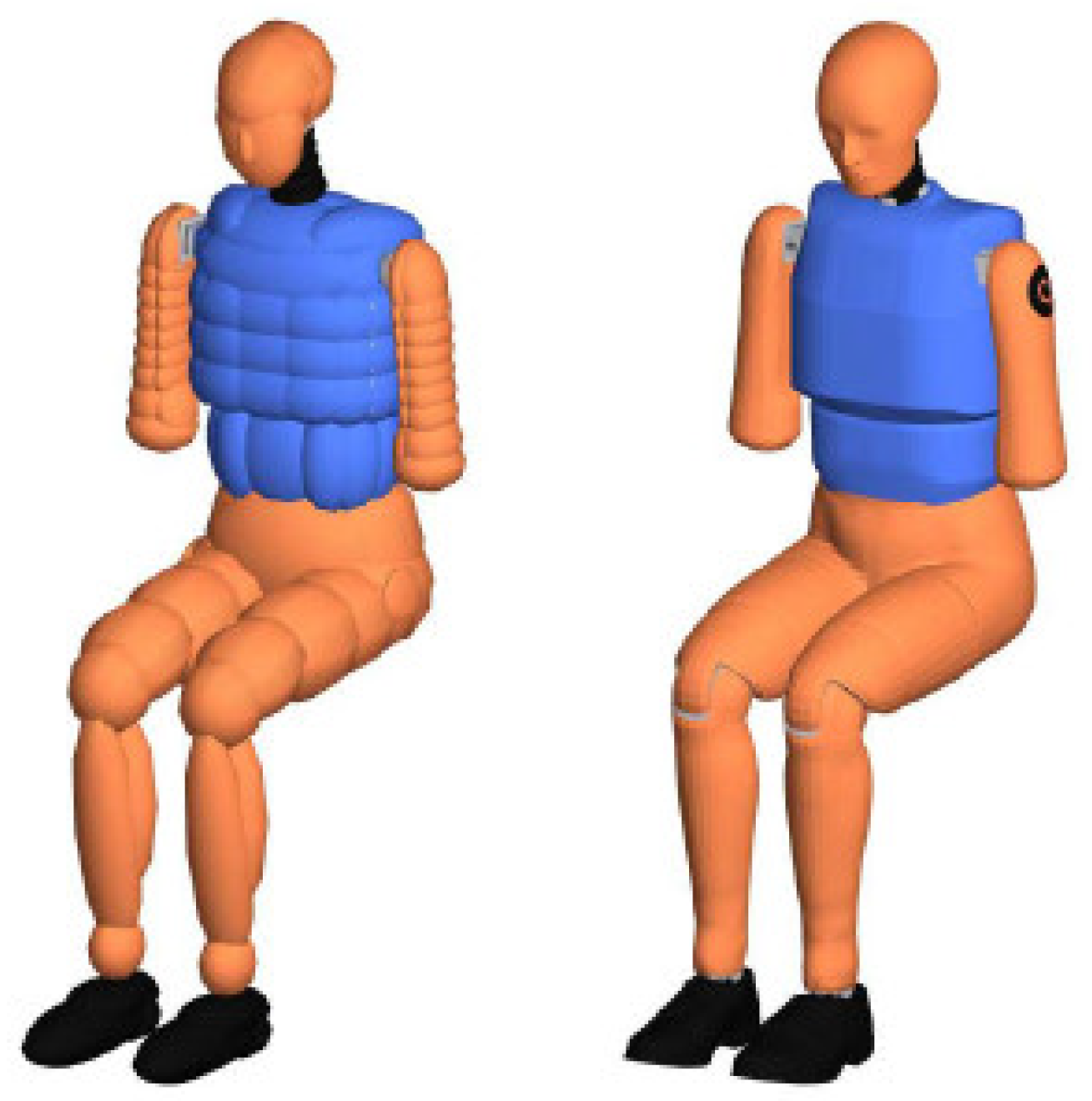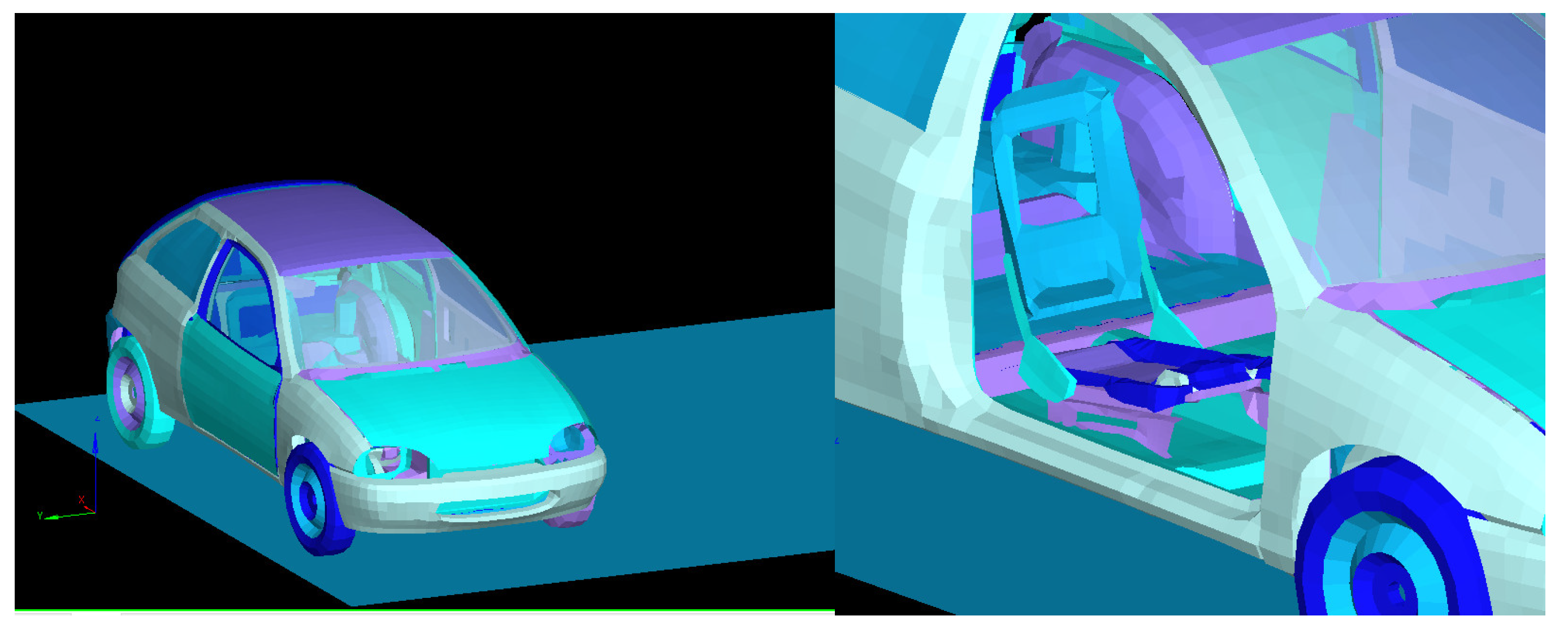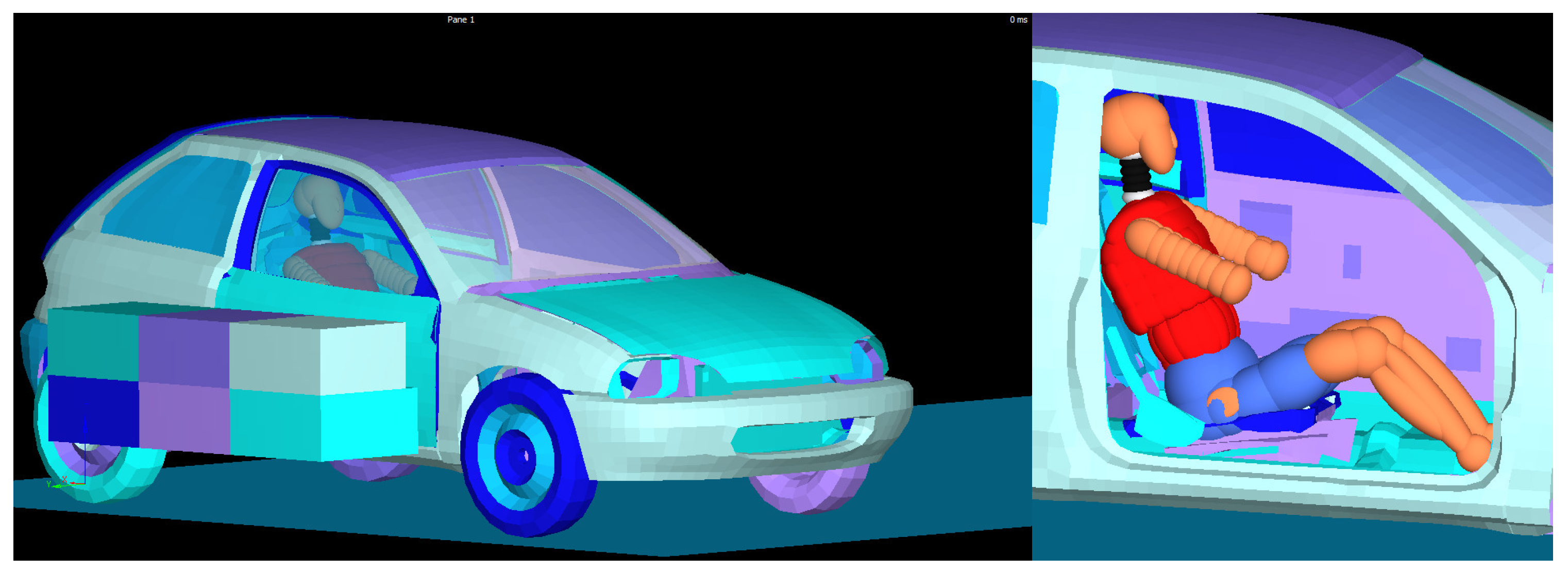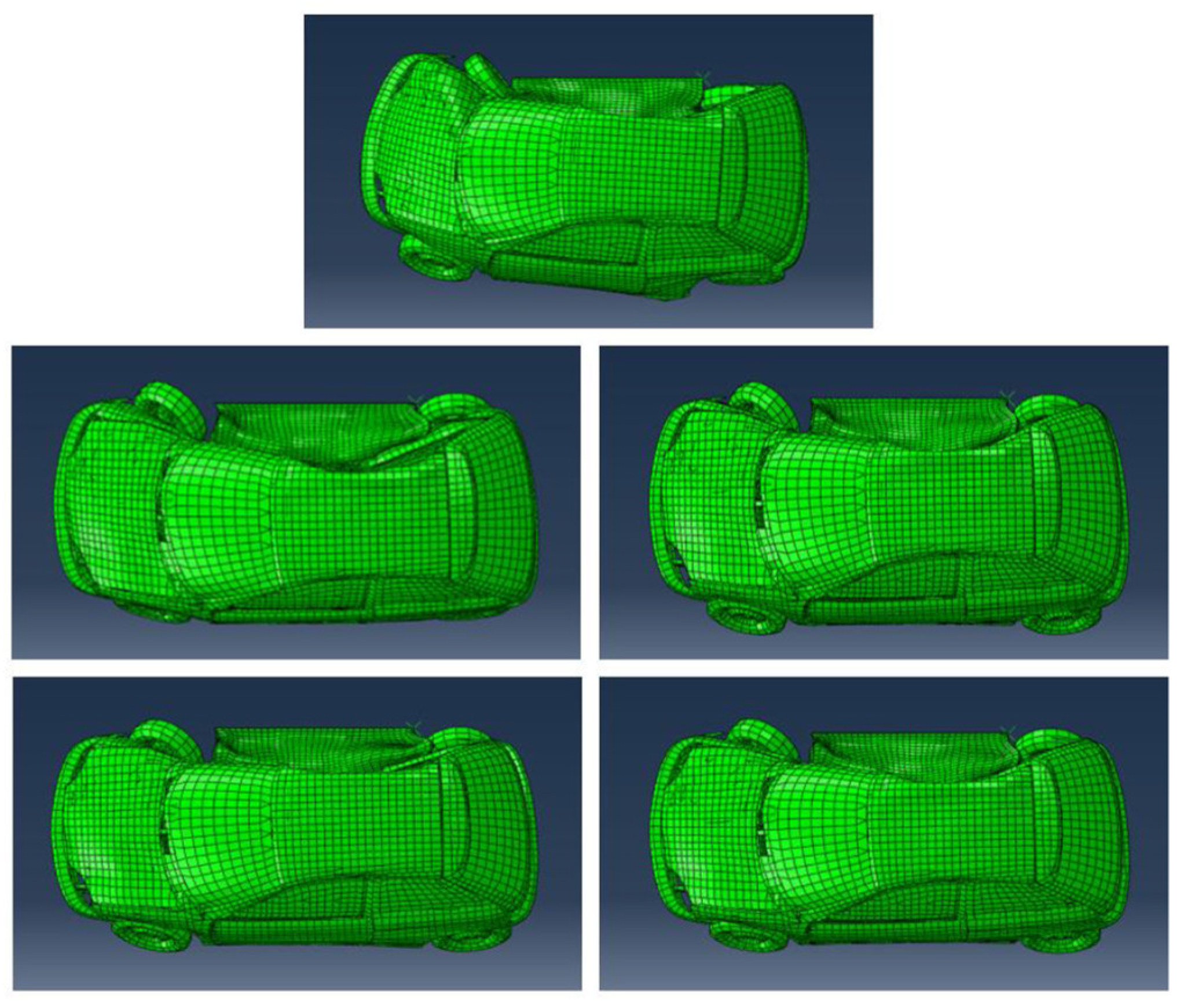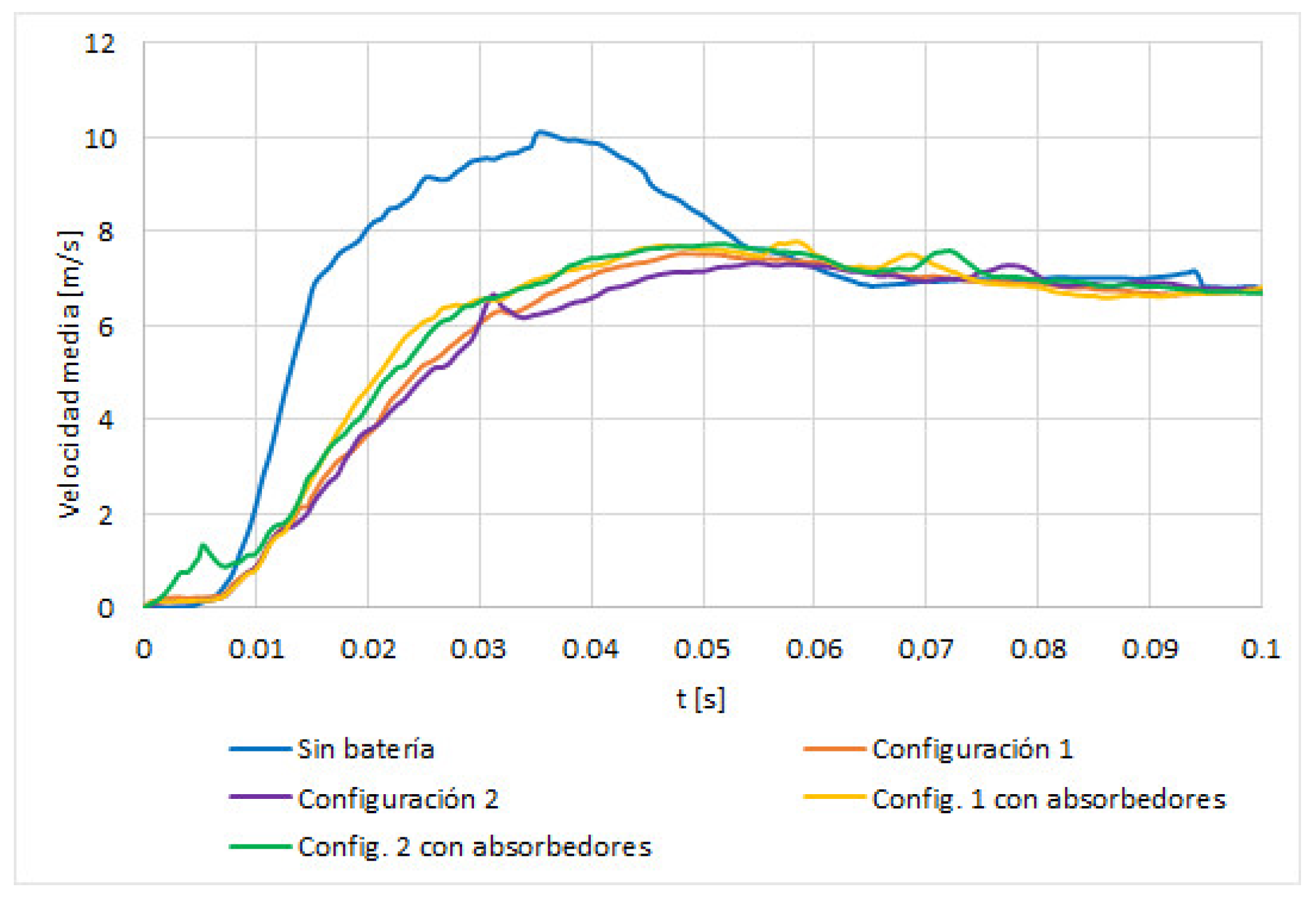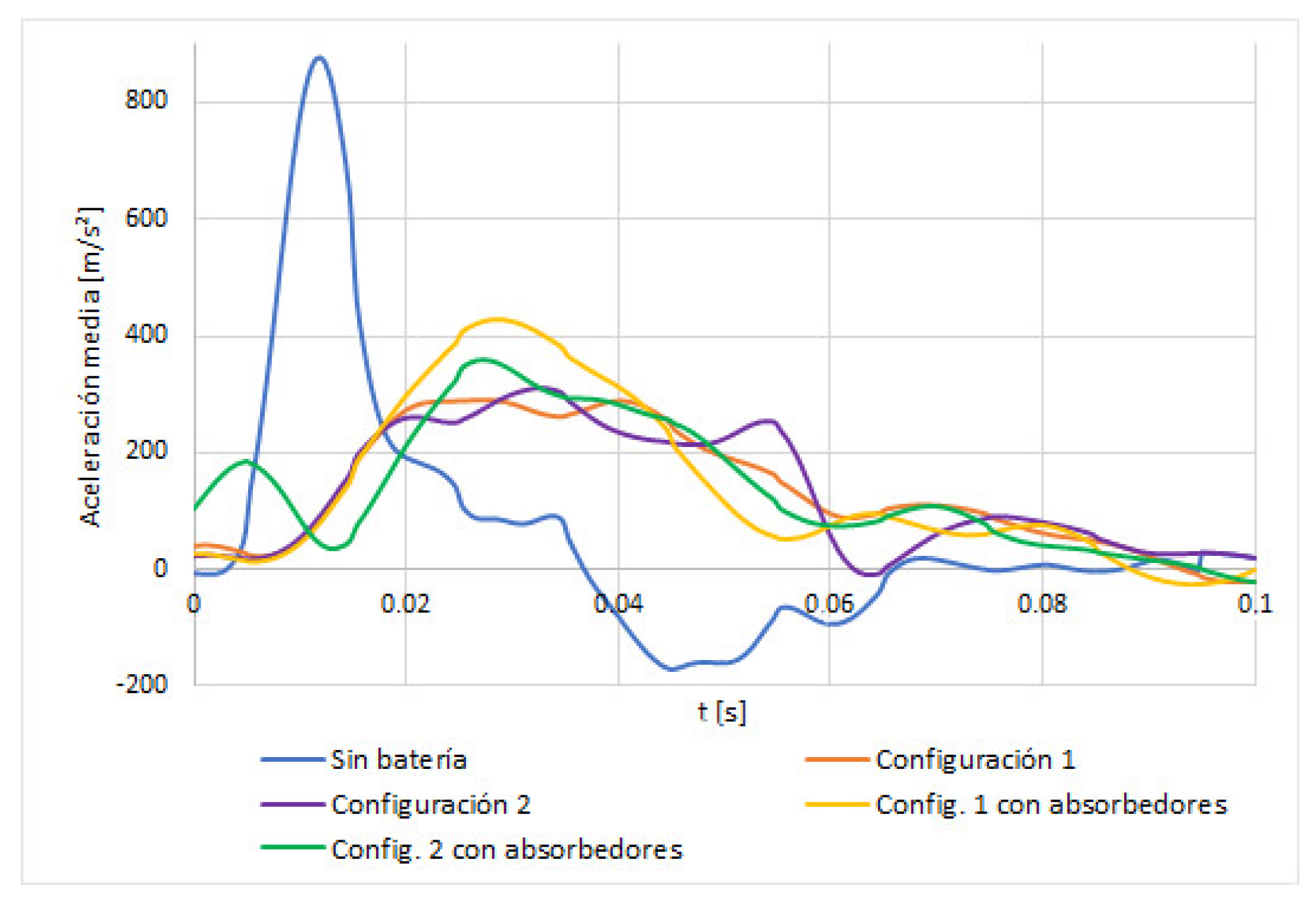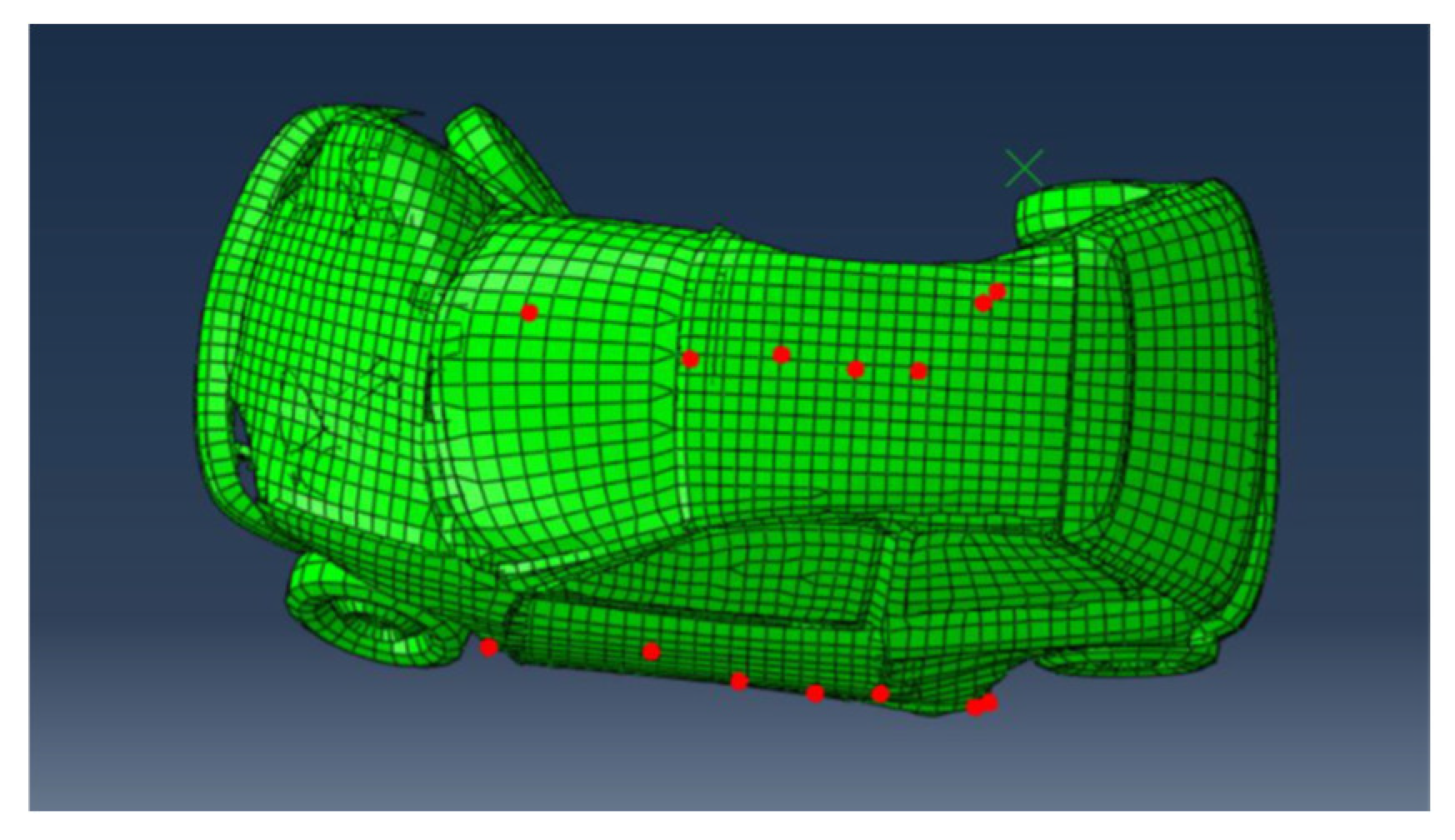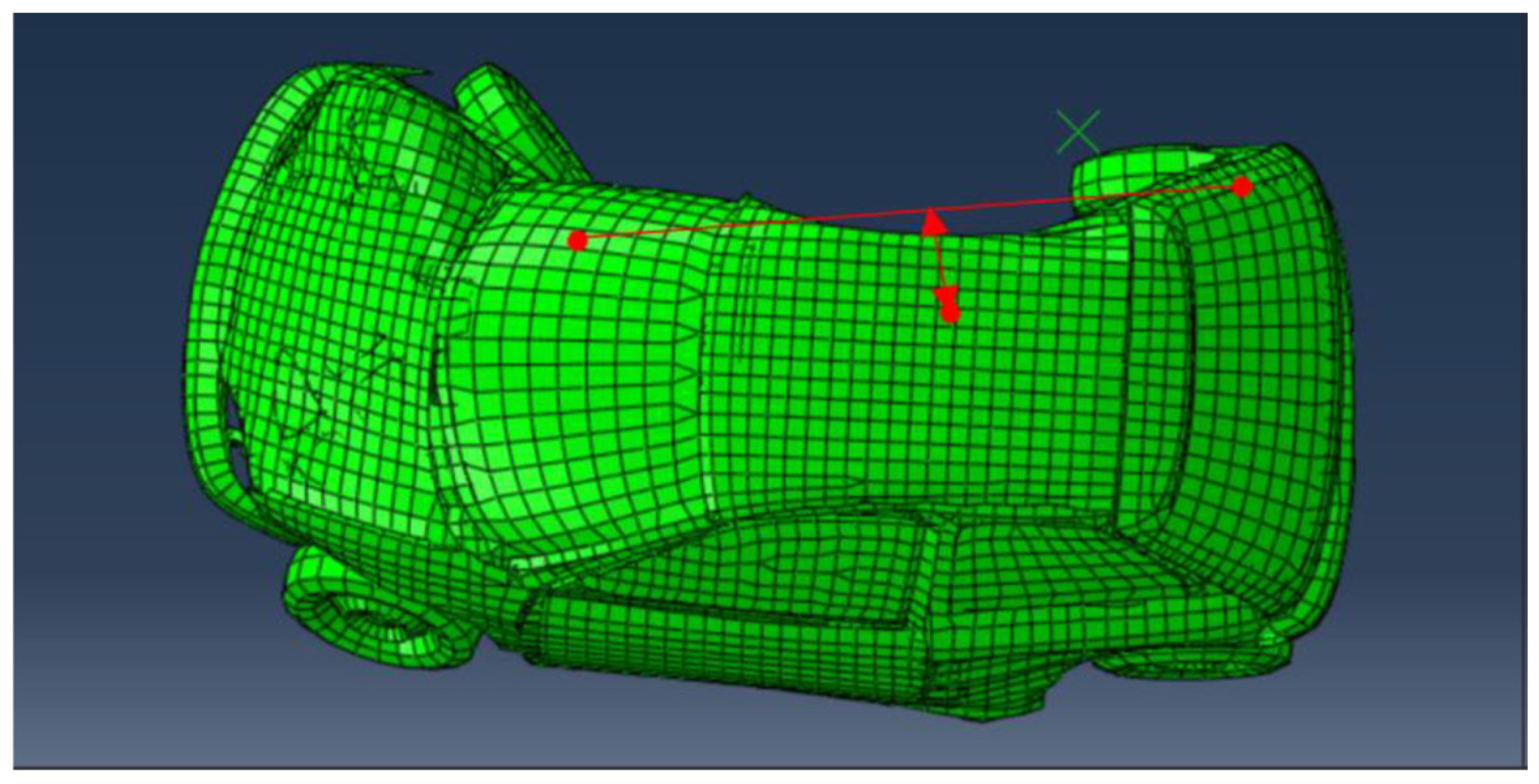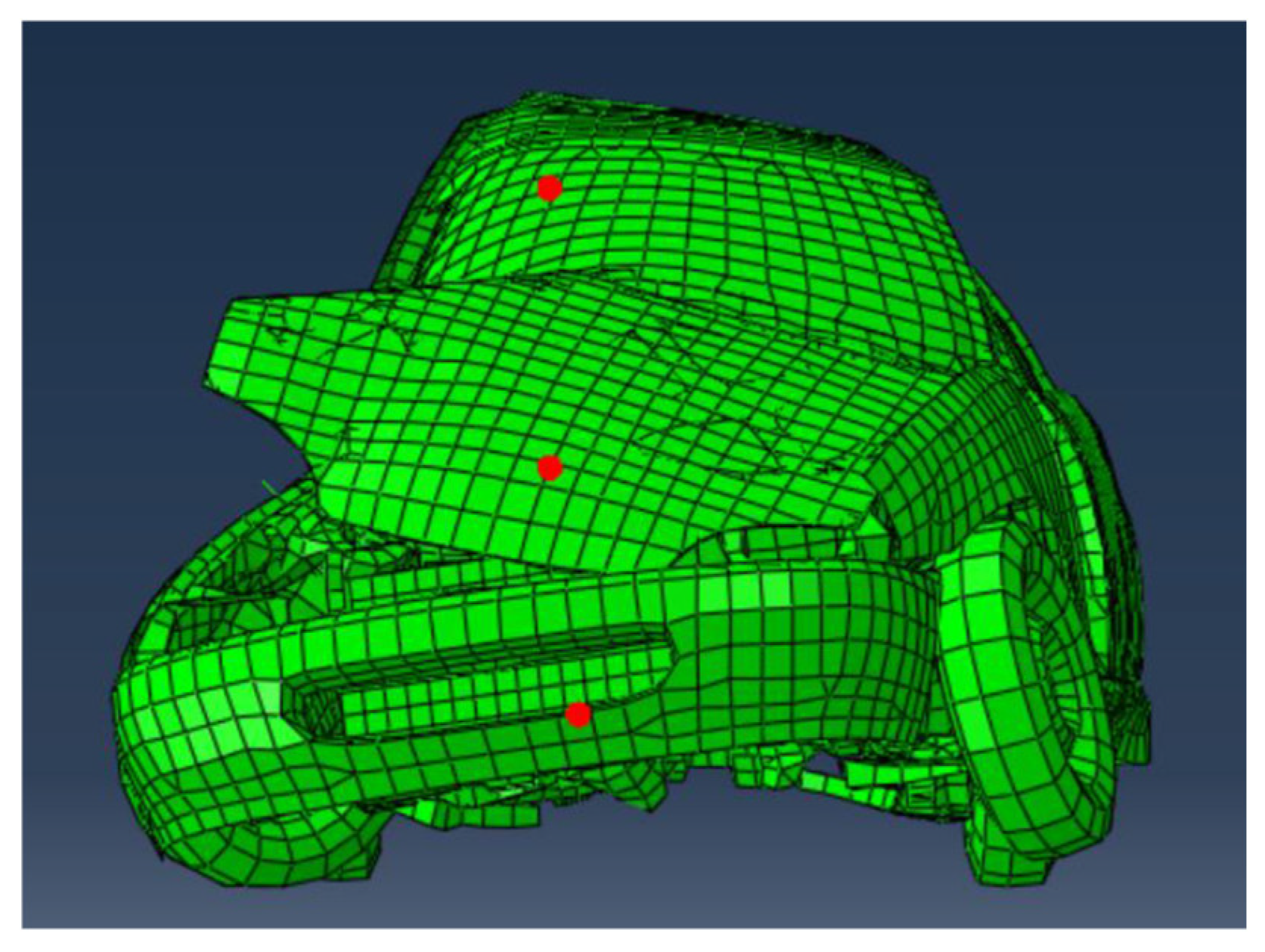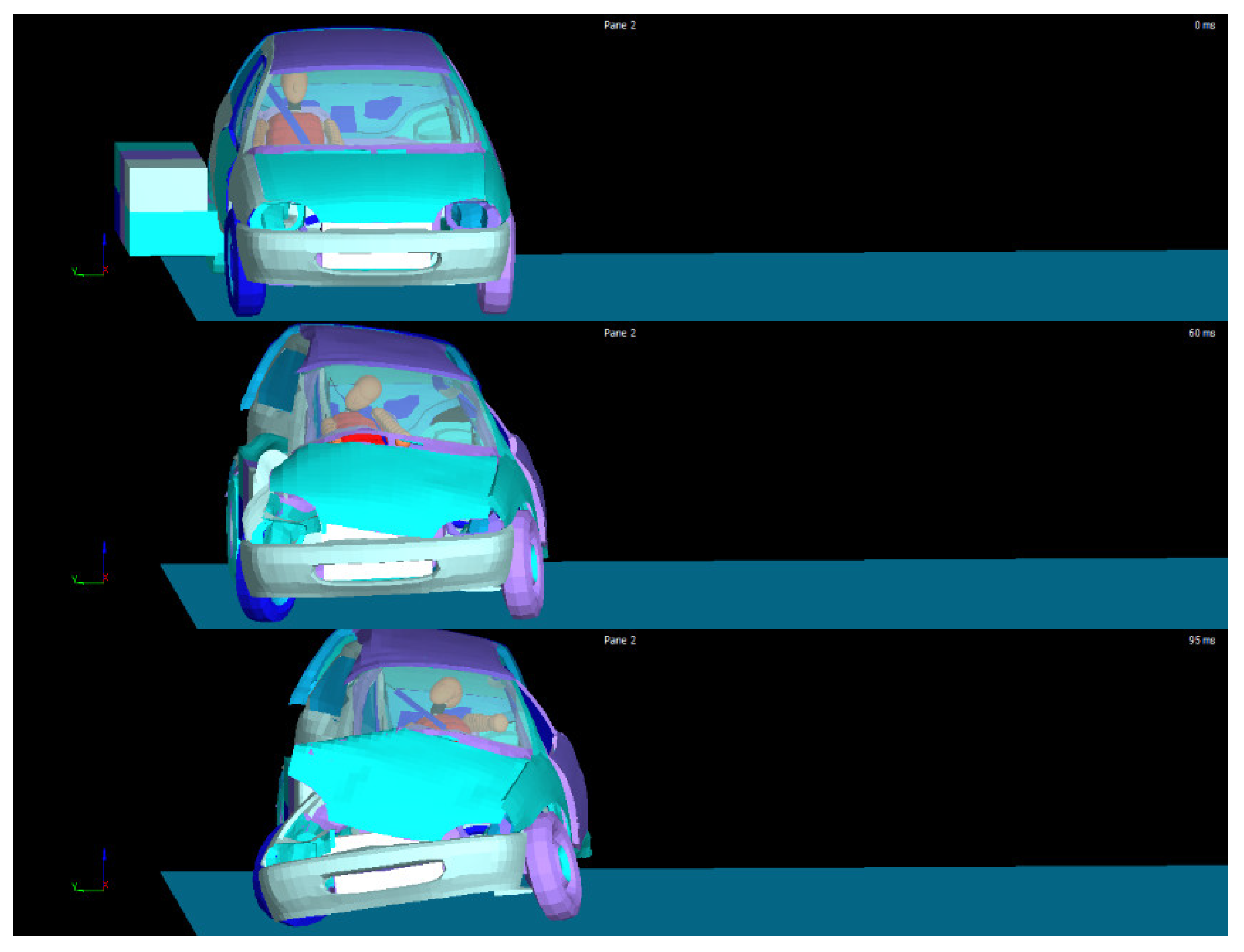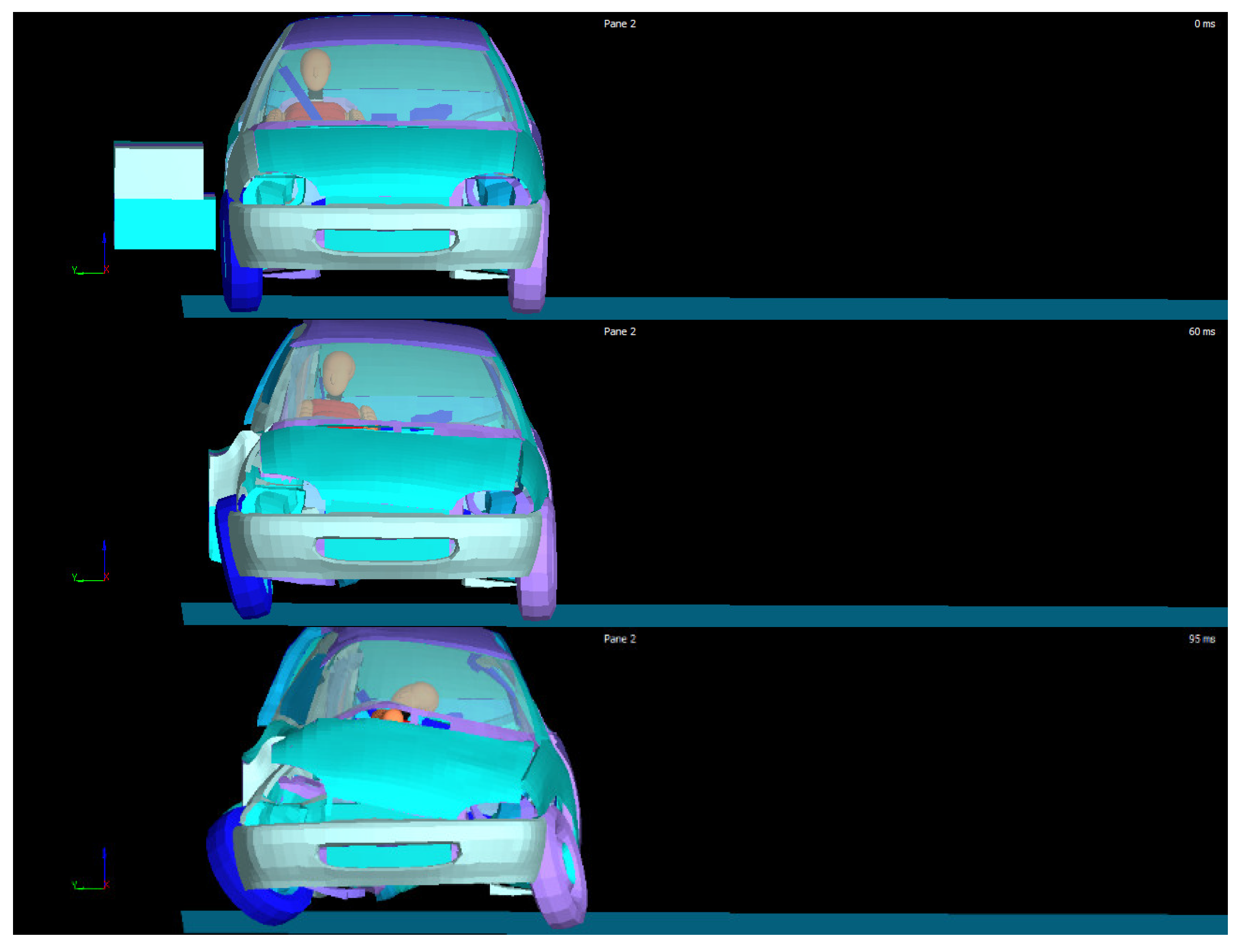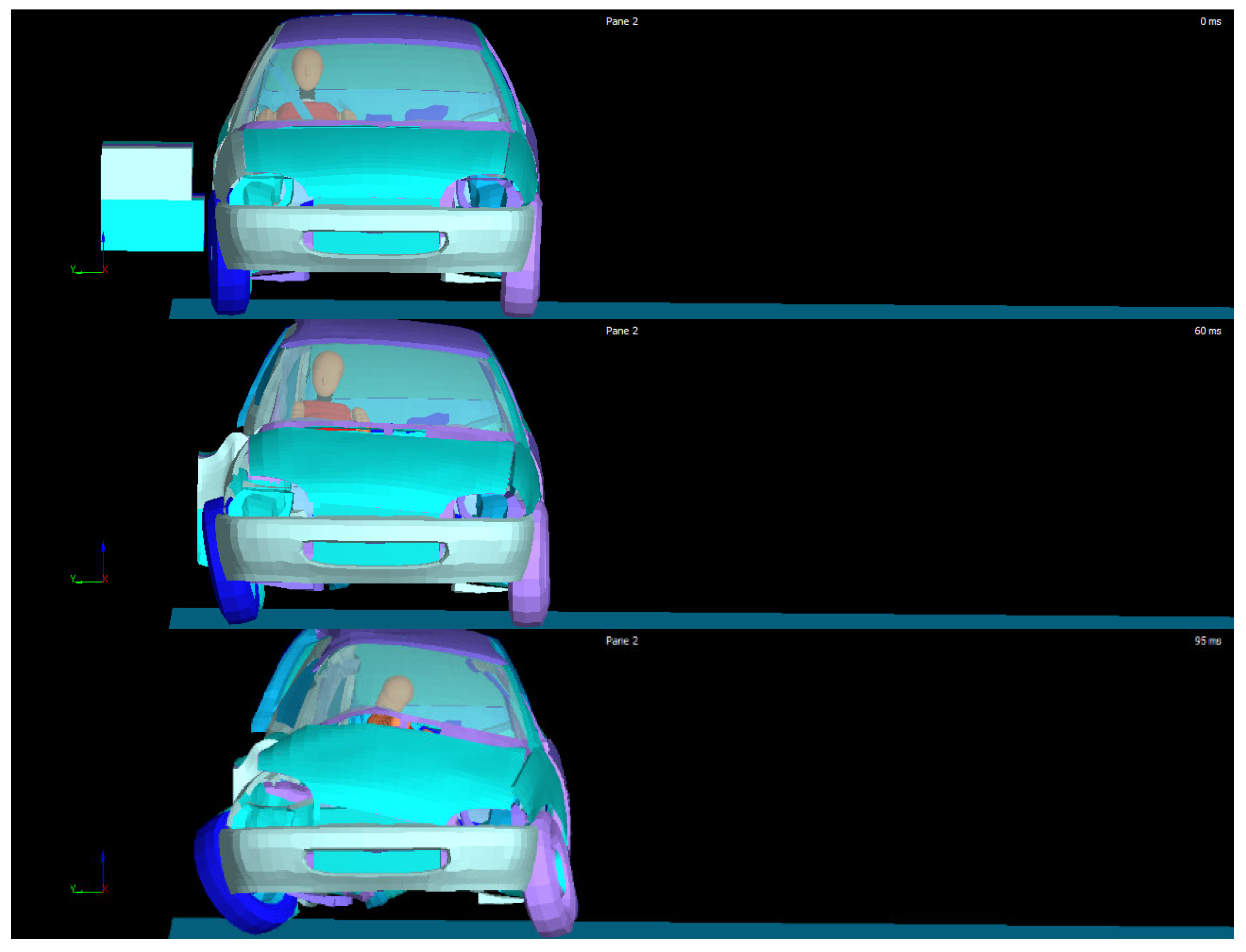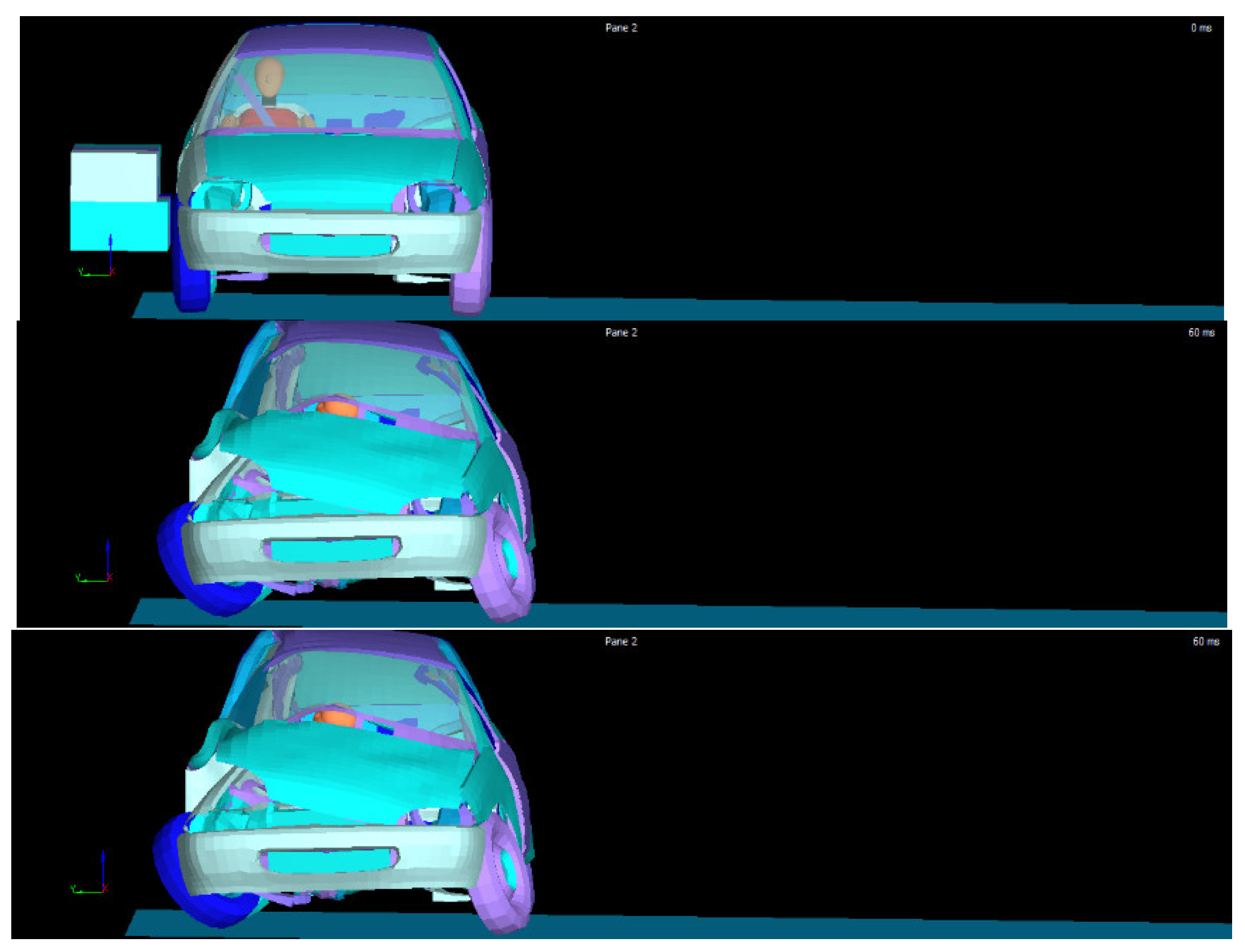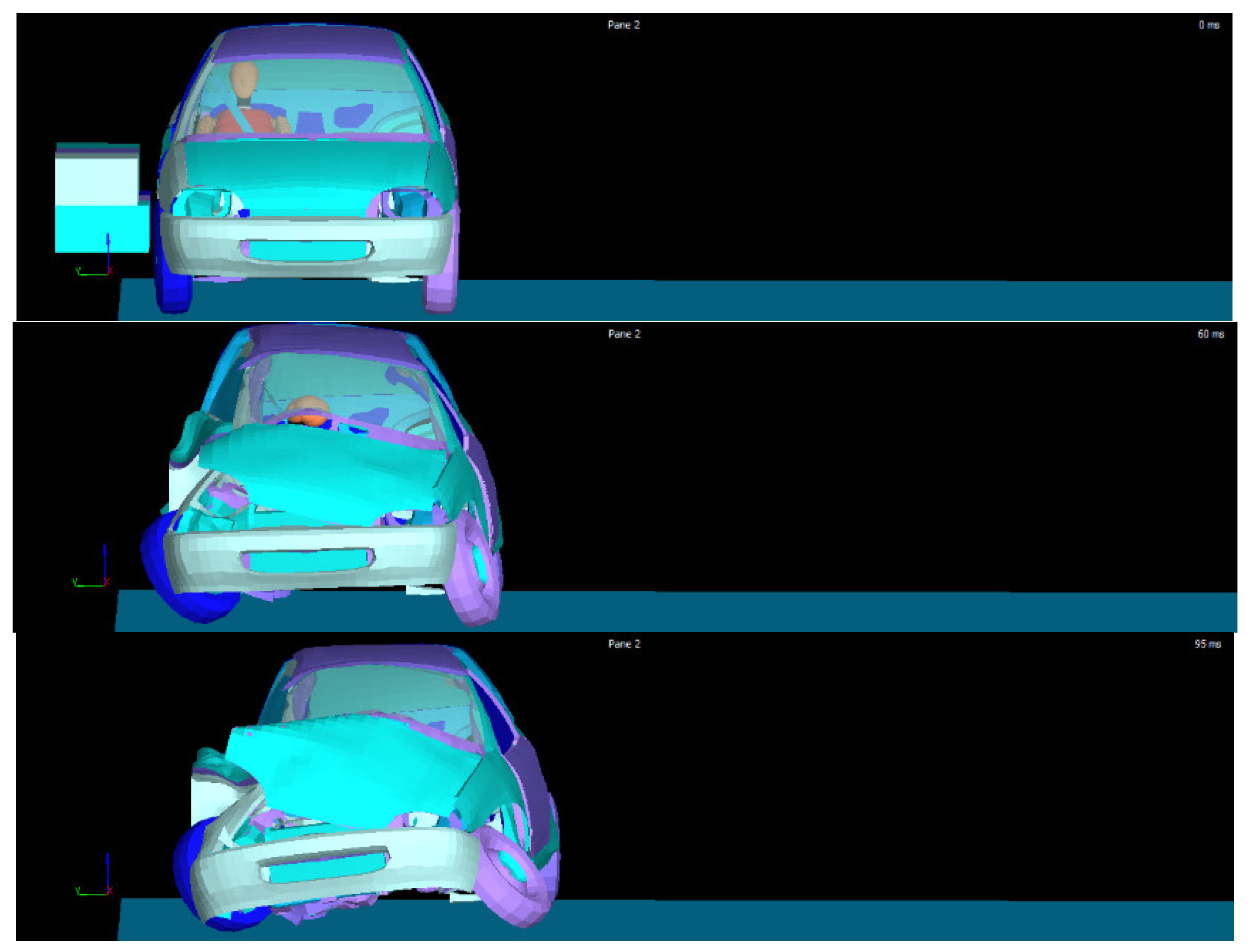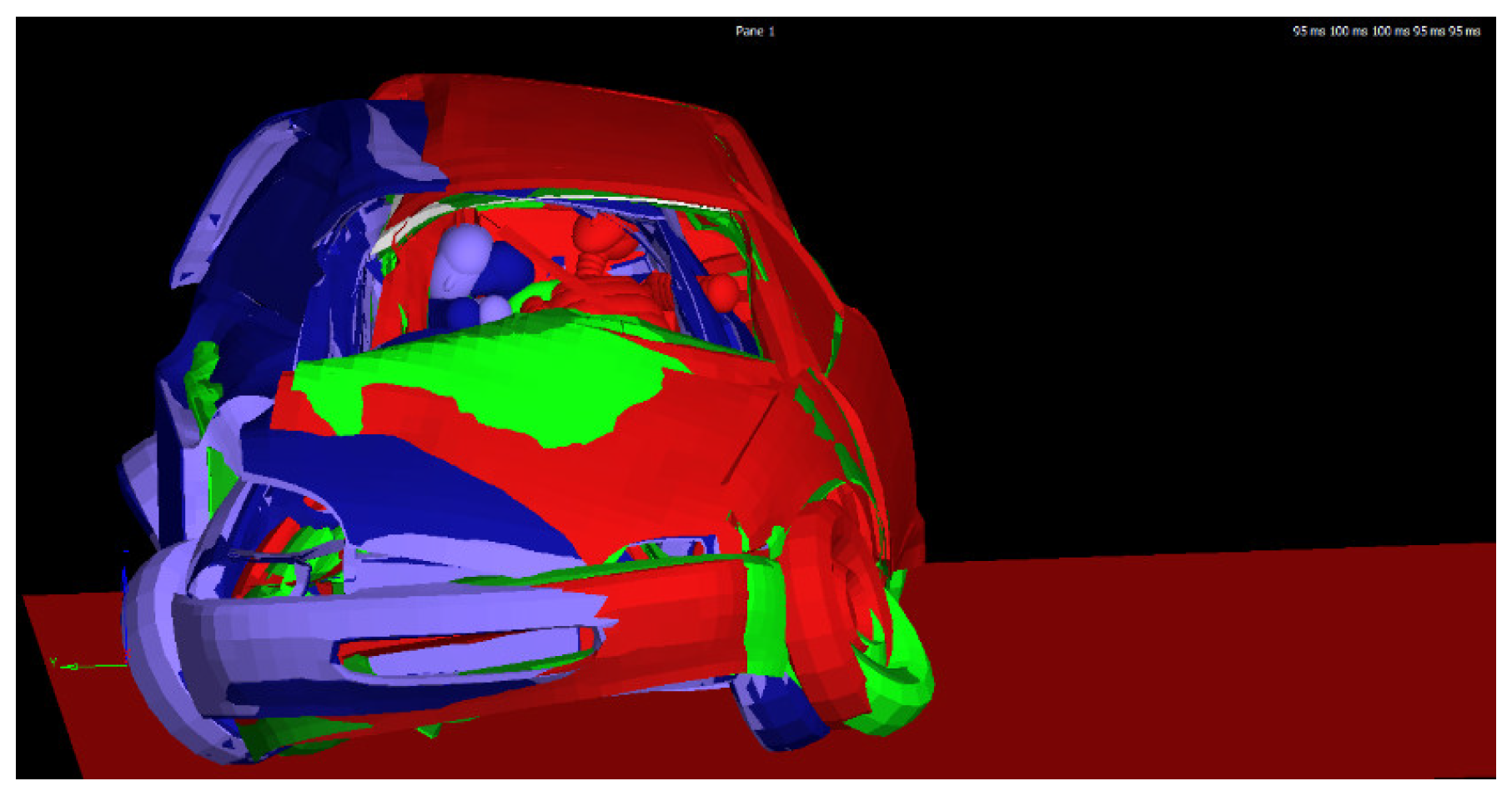Figure 1.
Thermal runaway mechanism of lithium-ion battery for EVs [
2].
Figure 1.
Thermal runaway mechanism of lithium-ion battery for EVs [
2].
Figure 2.
Diagram of side collision test with movable barrier according to ECE Regulation R95 [
5].
Figure 2.
Diagram of side collision test with movable barrier according to ECE Regulation R95 [
5].
Figure 3.
(a) Geo Metro 3-Door Gen II model; (b) Geo Metro 3 model modeled with finite elements. Model used as a reference.
Figure 3.
(a) Geo Metro 3-Door Gen II model; (b) Geo Metro 3 model modeled with finite elements. Model used as a reference.
Figure 4.
(a) Vehicle floor and area under rear bench of the reference vehicle; (b) adapted electric vehicle floor and area under rear bench to create room for the traction battery.
Figure 4.
(a) Vehicle floor and area under rear bench of the reference vehicle; (b) adapted electric vehicle floor and area under rear bench to create room for the traction battery.
Figure 5.
High-voltage battery layout in EV (a) configuration 1; (b) configuration 2.
Figure 5.
High-voltage battery layout in EV (a) configuration 1; (b) configuration 2.
Figure 6.
(a) Configuration 3: configuration 1 with shock absorbers; (b) configuration 4: configuration 2 with shock absorbers.
Figure 6.
(a) Configuration 3: configuration 1 with shock absorbers; (b) configuration 4: configuration 2 with shock absorbers.
Figure 7.
Comparison of four electric vehicle configurations analyzed.
Figure 7.
Comparison of four electric vehicle configurations analyzed.
Figure 8.
Explanation of the Vickers microhardness test.
Figure 8.
Explanation of the Vickers microhardness test.
Figure 9.
Test specimen obtained from the (a) upper and (b) lower casing of the high-voltage battery, and from the (c) casing of a high-voltage battery module.
Figure 9.
Test specimen obtained from the (a) upper and (b) lower casing of the high-voltage battery, and from the (c) casing of a high-voltage battery module.
Figure 10.
Views of the Vickers test on specimen from upper casing of high-voltage battery.
Figure 10.
Views of the Vickers test on specimen from upper casing of high-voltage battery.
Figure 11.
Views of the Vickers test on high-voltage battery module housing specimen.
Figure 11.
Views of the Vickers test on high-voltage battery module housing specimen.
Figure 12.
ES-2(re) ellipsoid dummy (
left), used in the simulation, and ES-2(re) faceted dummy (
right) in its reference position [
18].
Figure 12.
ES-2(re) ellipsoid dummy (
left), used in the simulation, and ES-2(re) faceted dummy (
right) in its reference position [
18].
Figure 13.
Image of the vehicle used, and details of the seat fitted for the dummy.
Figure 13.
Image of the vehicle used, and details of the seat fitted for the dummy.
Figure 14.
Whole model that was simulated according to ECE Regulation R95 using the EuroSID-2 dummy.
Figure 14.
Whole model that was simulated according to ECE Regulation R95 using the EuroSID-2 dummy.
Figure 15.
Deformed car model at the instant of maximum deformation. From left to right and from top to bottom: configuration without battery, configuration 1, configuration 2, configuration 1 with absorbers, and configuration 2 with absorbers.
Figure 15.
Deformed car model at the instant of maximum deformation. From left to right and from top to bottom: configuration without battery, configuration 1, configuration 2, configuration 1 with absorbers, and configuration 2 with absorbers.
Figure 16.
Average velocity (m/s) measured on vehicle ground during impact for each configuration.
Figure 16.
Average velocity (m/s) measured on vehicle ground during impact for each configuration.
Figure 17.
Average acceleration (m/s2) measured at vehicle floor during impact for each configuration.
Figure 17.
Average acceleration (m/s2) measured at vehicle floor during impact for each configuration.
Figure 18.
Nodes selected for calculation of dTmax and dTmean at instant of maximum penetration.
Figure 18.
Nodes selected for calculation of dTmax and dTmean at instant of maximum penetration.
Figure 19.
Nodes selected for the calculation of dH at the instant of maximum deformation.
Figure 19.
Nodes selected for the calculation of dH at the instant of maximum deformation.
Figure 20.
Nodes chosen for the calculation of dV at the instant of maximum deformation. The best configuration was configuration 1 with absorbers (Config.1 with shock-absorbing elements).
Figure 20.
Nodes chosen for the calculation of dV at the instant of maximum deformation. The best configuration was configuration 1 with absorbers (Config.1 with shock-absorbing elements).
Figure 21.
Kinematics of passenger in combustion vehicle subjected to a lateral collision according to ECE Regulation R95, using the ES-2 dummy.
Figure 21.
Kinematics of passenger in combustion vehicle subjected to a lateral collision according to ECE Regulation R95, using the ES-2 dummy.
Figure 22.
Kinematics of passenger for electric vehicle configuration 1 subjected to a lateral collision according to ECE Regulation R95, using the ES-2 dummy.
Figure 22.
Kinematics of passenger for electric vehicle configuration 1 subjected to a lateral collision according to ECE Regulation R95, using the ES-2 dummy.
Figure 23.
Kinematics of passenger for electric vehicle configuration 2 subjected to lateral collision according to ECE Regulation R95, using the ES-2 dummy.
Figure 23.
Kinematics of passenger for electric vehicle configuration 2 subjected to lateral collision according to ECE Regulation R95, using the ES-2 dummy.
Figure 24.
Kinematics of passenger for electric vehicle configuration 1 with energy absorbers, subjected to a lateral collision according to ECE Regulation R95, using the ES-2 dummy.
Figure 24.
Kinematics of passenger for electric vehicle configuration 1 with energy absorbers, subjected to a lateral collision according to ECE Regulation R95, using the ES-2 dummy.
Figure 25.
Kinematics of passenger for electric vehicle configuration 2 with energy absorbers, subjected to a lateral collision according to ECE Regulation R95, using the ES-2 dummy.
Figure 25.
Kinematics of passenger for electric vehicle configuration 2 with energy absorbers, subjected to a lateral collision according to ECE Regulation R95, using the ES-2 dummy.
Figure 26.
Passenger kinematic comparison for different vehicle configurations.
Figure 26.
Passenger kinematic comparison for different vehicle configurations.
Figure 27.
Comparison of head acceleration in each of analyzed configurations.
Figure 27.
Comparison of head acceleration in each of analyzed configurations.
Figure 28.
VC at upper ribs for each of the configurations analyzed.
Figure 28.
VC at upper ribs for each of the configurations analyzed.
Figure 29.
VC at middle ribs for each of the configurations analyzed.
Figure 29.
VC at middle ribs for each of the configurations analyzed.
Figure 30.
VC at lower ribs for each of the configurations analyzed.
Figure 30.
VC at lower ribs for each of the configurations analyzed.
Figure 31.
APF value for each of the configurations analyzed.
Figure 31.
APF value for each of the configurations analyzed.
Figure 32.
PSPF value for each of the configurations analyzed.
Figure 32.
PSPF value for each of the configurations analyzed.
Figure 33.
Fy in backplate for each of the configurations analyzed.
Figure 33.
Fy in backplate for each of the configurations analyzed.
Figure 34.
Fy at the T12 vertebra for each of the configurations analyzed.
Figure 34.
Fy at the T12 vertebra for each of the configurations analyzed.
Figure 35.
Mx at the T12 vertebra for each of the configurations analyzed.
Figure 35.
Mx at the T12 vertebra for each of the configurations analyzed.
Table 1.
Properties of aluminum foam.
Table 1.
Properties of aluminum foam.
| Density (kg/m3) | 390 |
| Young’s modulus (GPa) | 0.175 |
| Poisson’s ratio (-) | 0.05 |
Table 2.
Results of Vickers microhardness tests on different specimens.
Table 2.
Results of Vickers microhardness tests on different specimens.
| | P (kg) | d1 (mm) | d2 (mm) | HV (kg/mm2) |
|---|
| Upper housing cover | 0.5 | 0.094941 | 0.1956 | 108.005069 |
| 0.5 | 0.0897204 | 0.1937 | 115.480832 |
| | | | 111.742951 |
| Lower housing cover | 0.5 | 0.094941 | 0.2031 | 104.076514 |
| 0.5 | 0.0903672 | 0.1962 | 113.193268 |
| | | | 108.634891 |
| Module housing | 0.5 | 0.1103256 | 0.2582 | 70.3455591 |
| 0.5 | 0.114807 | 0.2409 | 72.5473466 |
| | | | 71.4464529 |
Table 3.
Properties of DC01 steel [
15].
Table 3.
Properties of DC01 steel [
15].
| Density (kg/m3) | 7850 |
| Young’s modulus (GPa) | 210 |
| Poisson’s ratio (-) | 0.3 |
Table 4.
Plastic behavior of DC01 steel.
Table 4.
Plastic behavior of DC01 steel.
| Yield and Ultimate Strength (MPa) | Associated Plastic Strain |
|---|
| 330 | 0 |
| 365.7 | 0.18 |
Table 5.
Properties of aluminum 6063-T6.
Table 5.
Properties of aluminum 6063-T6.
| Density (kg/m3) | 2700 |
| Young’s modulus (GPa) | 69 |
| Poisson’s ratio (-) | 0.33 |
Table 6.
Plastic behavior of aluminum 6063-T6.
Table 6.
Plastic behavior of aluminum 6063-T6.
| Yield and Ultimate Strength (MPa) | Associated Plastic Strain |
|---|
| 215 | 0 |
| 240 | 0.10 |
Table 7.
Equivalent properties of interior of modules.
Table 7.
Equivalent properties of interior of modules.
| | LiMn2O4 (25%) | LiNiO2 (25%) | Graphite (50%) | Equivalent Module Material |
|---|
| Density (kg/m3) | 4140 | 4650 | 2300 | 3347.5 |
| Young’s modulus (GPa) | 194 | 194 | 109 | 151.5 |
| Poisson’s ratio (-) | 0.26 | 0.26 | 0.24 | 0.25 |
Table 8.
Comparison of instant of maximum deformation of the car model.
Table 8.
Comparison of instant of maximum deformation of the car model.
| | Without Battery | Config. 1 | Conf. 2 | Config. 1 with Shock-Absorbing Elements | Config. 2 with Shock-Absorbing Elements |
|---|
| Time of maximum deformation(s) | 0.1 | 0.0615 | 0.0625 | 0.056 | 0.058 |
Table 9.
Comparison of maximum speed and acceleration.
Table 9.
Comparison of maximum speed and acceleration.
| | Without
Battery | Config. 1 | Conf. 2 | Config. 1 with Shock-Absorbing Elements | Config. 2 with Shock-Absorbing Elements |
|---|
| Maximum Velocity (m/s) | 10.09 | 7.52 | 7.35 | 7.77 | 7.73 |
| Maximum Acceleration (m/s2) | 876.49 | 291.12 | 310.65 | 427.49 | 360.06 |
Table 10.
Comparison of protection elements.
Table 10.
Comparison of protection elements.
| | Without Battery | Config. 1 | Config. 2 | Config. 1 with Shock-Absorbing Elements | Config. 2 with Shock-Absorbing Elements |
|---|
| Side sill | Edeformmax (J) | 939.08 | 1472.23 | 1597.28 | 878.17 | 784.30 |
| σVMmax (MPa) | 982.1 1 | 1089 2 | 991.8 1 | 909.6 1 | 895.8 1 |
| Housing | Edeformmax (J) | - | 2125.87 | 2515.62 | 1908.04 | 1782.96 |
| σVMmax (MPa) | - | 365.7 2 | 360.5 1 | 339.6 1 | 351.3 1 |
Shock
absorber | Edeformmax (J) | - | - | - | 684.09 | 729.94 |
| ⅀Edeformmax (J) | 939.08 | 3598.1 | 4112.9 | 3470.31 | 3297.20 |
Table 12.
Comparison of protection elements.
Table 12.
Comparison of protection elements.
| | Without
Battery | Config. 1 | Config. 2 | Config. 1 with Shock-Absorbing Elements | Config. 2 with Shock-Absorbing Elements |
|---|
| dTmax(mm) | 333.55 | 224.85 | 253.02 | 205.55 | 253.48 |
| dTmax(mm) | 252.60 | 128.86 | 160.31 | 93.87 | 100.67 |
Table 13.
Intrusion at B pillar for the different configurations.
Table 13.
Intrusion at B pillar for the different configurations.
| | Without
Battery | Config. 1 | Config. 2 | Config. 1 with Shock-Absorbing Elements | Config. 2 with Shock-Absorbing Elements |
|---|
| dH(mm) | 351.48 | 222.91 | 238.96 | 160.19 | 120.95 |
| dV(mm) | 101.32 | 103.71 | 108.85 | 85.30 | 81.24 |
Table 14.
HIC36 experienced by the dummy for each of analyzed configurations.
Table 14.
HIC36 experienced by the dummy for each of analyzed configurations.
| | Without
Battery | Config. 1 | Config. 2 | Config. 1 with Shock-Absorbing Elements | Config. 2 with Shock-Absorbing Elements |
|---|
| HIC36 | 37.972 | 13.424 | 20.681 | 113.706 | 79.038 |
Table 15.
Rib compression and viscosity criterion (VC) for each of analyzed configurations.
Table 15.
Rib compression and viscosity criterion (VC) for each of analyzed configurations.
| | Without
Battery | Config. 1 | Config. 2 | Config. 1 with Shock-Absorbing Elements | Config. 2 with Shock-Absorbing Elements |
|---|
| Upper Rib Compr. (mm) | 59.47 | 52.24 | 55.08 | 75.90 | 67.26 |
| Mid Rib Compr. (mm) | 69.51 | 46.13 | 48.39 | 48.82 | 42.25 |
| Lower Rib Comp. (mm) | 68.70 | 56.66 | 64.15 | 38.37 | 30.18 |
| Upper Rib VC (m/s) | 1.57 | 1.38 | 1.33 | 3.71 | 2.61 |
| Mid Rib VC (m/s) | 1.94 | 1.15 | 1.34 | 1.46 | 1.03 |
| Lower Rib VC (m/s) | 2.14 | 1.78 | 2.43 | 1.06 | 0.57 |
Table 16.
APF value (maximum force in the abdomen) for each of the configurations analyzed.
Table 16.
APF value (maximum force in the abdomen) for each of the configurations analyzed.
| | Without
Battery | Config. 1 | Config. 2 | Config. 1 with Shock-Absorbing Elements | Config. 2 with Shock-Absorbing Elements |
|---|
| APF (N) | 9168.0 | 1277.0 | 1539.9 | 1707.0 | 1558.9 |
Table 17.
Maximum value of maximum force on pubic symphysis (PSPF) for each of the configurations analyzed.
Table 17.
Maximum value of maximum force on pubic symphysis (PSPF) for each of the configurations analyzed.
| | Without
Battery | Config. 1 | Config. 2 | Config. 1 with Shock-Absorbing Elements | Config. 2 with Shock-Absorbing Elements |
|---|
| PSPF (N) | 5792.11 | 4.609.2 | 4.864.3 | 3.323.9 | 2.642.9 |
Table 18.
Value of the modifier parameters for each of the configurations analyzed.
Table 18.
Value of the modifier parameters for each of the configurations analyzed.
| | Without
Battery | Config. 1 | Config. 2 | Config. 1 with Shock-Absorbing Elements | Config. 2 with Shock-Absorbing elements |
|---|
| Fy force in backplate | 3648.2 | 797.77 | 1194.1 | 3722.3 | 954.81 |
| Fy force in T12 | 10,493.0 | 3161.2 | 5071.2 | 7036.6 | 6576.8 |
| Mx torque in T12 | 630.57 | 305.85 | 310.55 | 379.45 | 335.50 |
